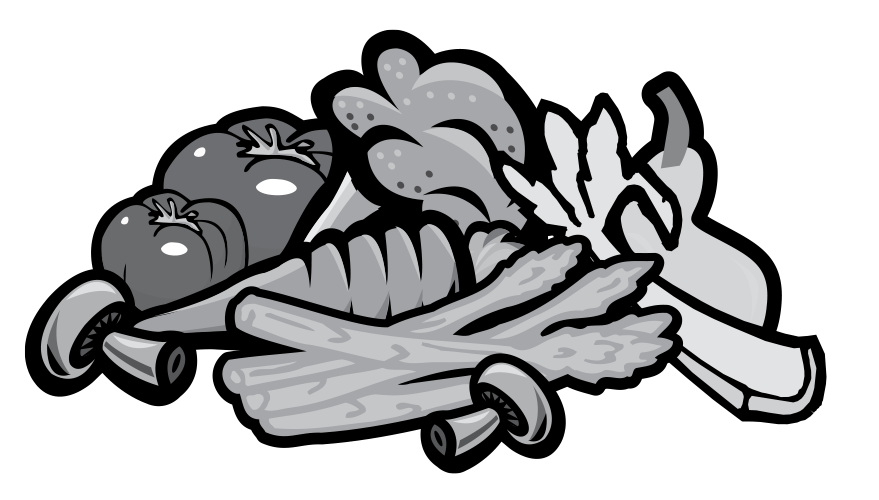Agricultural Literacy Curriculum Matrix
Lesson Plan
Nutritional Value of Fresh Produce
Grade Level
Purpose
Students determine that fresh produce is a good source of vitamin A, vitamin C, and fiber, and that all fruits and vegetables do not contain the same quantities of each nutrient. Grades 3-5
Estimated Time
Materials Needed
For each student:
- Fresh Fruits and Vegetables Nutrition Facts handout
- Dietary Fiber bar graph activity sheets
- Colored pencils, crayons, or markers
- Nutrient Comparison activity sheet
- Nutrient Comparison Answer Key
For the teacher:
- Document Camera
- Markers
Vocabulary
ascorbic acid: another name for vitamin C; necessary in the body for healthy cells
citric acid: an organic acid which acts as a natural preservative; used to add an acidic, or sour taste to foods and beverages
fruit: the part of a plant that develops from the flower and contains the seeds of the plant
produce: fresh fruits and vegetables
vegetable: any edible part of a plant that does not contain seeds
Background Agricultural Connections
This lesson is part of a series called Fruits and Vegetables for Health, which introduces students to the production, distribution, and nutritional value of fresh produce. Students will gain knowledge in geography, language arts, science, and math as they learn about the process through which fruits and vegetables are transported from California farms to kitchen tables. Other related lessons in this series include:
- Making Half MyPlate Fruits and Vegetables
- California Crops: From the Farm to the Table
- Nutritional Value of Fresh Produce
- The Chemistry of Fruits and Vegetables
- My Life as a Fruit or Vegetable
 The Percent Daily Value on the Nutrition Facts label is a guide to the nutrients in one serving of food. For example, if the label lists 5 Percent Daily Value for fiber, it means that one serving provides 5 percent of the fiber you need each day.
The Percent Daily Value on the Nutrition Facts label is a guide to the nutrients in one serving of food. For example, if the label lists 5 Percent Daily Value for fiber, it means that one serving provides 5 percent of the fiber you need each day.
The Daily Values are average levels of nutrients for a person eating 2,000-calories a day. For children, the amount needed will be slightly lower. Even if a person’s diet is higher or lower in calories, they can still use the Percent Daily Value as a guide. Percent daily values are the entire day, not just one snack or meal. For example, the Percent Daily Value can help students determine whether a food is high or low in specific nutrients:
If a food has 5 percent or less of a nutrient, it’s considered to be low in that nutrient. If it has 20 percent or more, it’s considered to be high in that nutrient.
To get the most benefit from Percent Daily Values, use them to choose foods high in vitamins, minerals and fiber—and to limit foods high in fat, cholesterol, and sodium. This lesson is designed to help students visualize which fruits and vegetables are the richest sources of vitamin A, vitamin C, and fiber.
Vitamin A is essential for maintaining good vision, fighting infection, supporting cell growth, and keeping skin healthy. Research has shown that consuming one serving a day of a food containing vitamin A may help prevent some kinds of cancer.
Vitamin C (ascorbic acid) is a powerful antioxidant. These nutrients help protect cells from damage that can increase the risk for certain diseases, such as cancer. Vitamin C helps the body heal cuts and wounds and helps lower the risk of infection.
Dietary fiber naturally occurs in plants, helps provide a feeling of fullness, helps keep your blood sugar level normal, and helps to avoid constipation. Sources of dietary fiber include dry beans and legumes, vegetables, fruits, whole grains, and nuts.
Engage
- Ask students to use their prior knowledge to list foods that are healthy for us to eat. Accept all reasonable answers and list several healthy foods on the board. Focus primarily on the fresh fruits and vegetables the students list.
- Refer to the list on the board and ask students, "What makes these foods healthy for us to eat?" Introduce students to vitamins minerals and fiber. Use the information provided in the Background Agricultural Connections section of this lesson to give them a basic understanding of the benefits we receive from vitamins, minerals, and fiber.
Explore and Explain
- Distribute copies of the Fresh Fruits and Vegetables Nutrition Facts handout to individual students or small groups of two or three. Review one Nutrition Facts label with the class to make certain that students understand how to read them. Using a document camera to show the handout may be helpful.
- Distribute copies of the Dietary Fiber bar graph activity sheets. Review the procedure for making bar graphs. You may wish to make an example blank graph to use in your explanation of bar graphing. Remind students that all graphs contain the following:
- labels for the vertical axes
- a title
- evenly divided horizontal and vertical axes
- accurate data
 Have students complete the bar graphs.
Have students complete the bar graphs.- Distribute and discuss the Nutrient Comparison activity sheet. Instruct students to use their bar graphs to complete the activity sheet. Discuss the answers.
Variations
- Have students create their own bar graphs on graph paper. Instruct them to label the x- and y-axes, determine appropriate increments, and give their graph a title.
- Have students create large nutrition pictographs or bar graphs for posting or display in the school cafeteria or library.
Elaborate
-
Have a tasting party of the fruits and vegetables you have studied. Ask the students to make a survey of the most popular fruits and vegetables among the class members and prepare graphs that display the results of the survey.
Evaluate
After conducting these activities, review and summarize the following key concepts:
- Fruits and vegetables are part of a healthy diet.
- Fruits and vegetables provide vitamins, minerals, and fiber to our diet.
Acknowledgements
This lesson was originally developed in 1996 through a partnership between the Fresh Produce and Floral Council, the California Farm Bureau Federation, and the California Foundation for Agriculture in the Classroom. Fruits and Vegetables for Health was updated in 2012 in partnership with the California Department of Public Health’s Network for a Healthy California with funding from USDA SNAP, known in California as CalFresh (formerly Food Stamps). Funding for 2017 updates were provided through a California Agriculture Special Interest License Plate grant (CalAgPlate) that supports agricultural education, agricultural career training, and agricultural leadership development.
Original Authors: Brenda Byers and Priscilla Naworski
Executive Director: Judy Culbertson
Illustrator: Erik Davison
Layout and Design: Nina Danner
Special thanks to Harvest of the Month
Recommended Companion Resources
Author
Organization
| We welcome your feedback! If you have a question about this lesson or would like to report a broken link, please send us an email. If you have used this lesson and are willing to share your experience, we will provide you with a coupon code for 10% off your next purchase at AgClassroomStore. |
